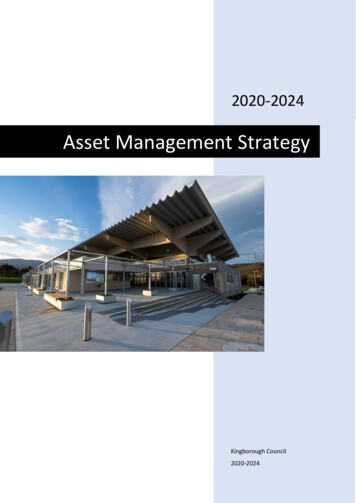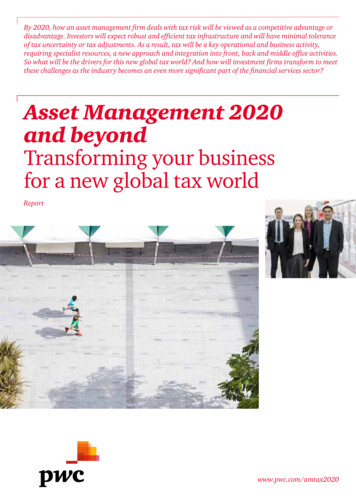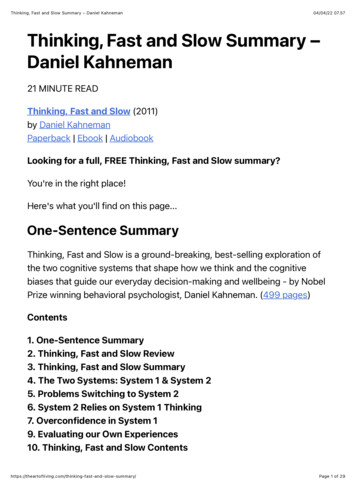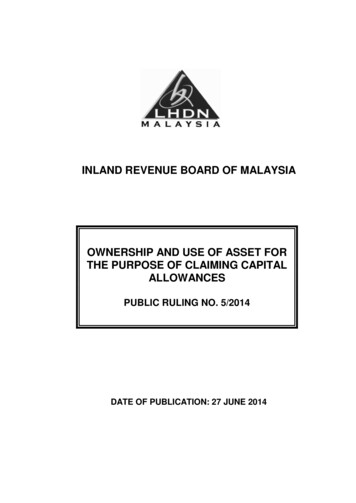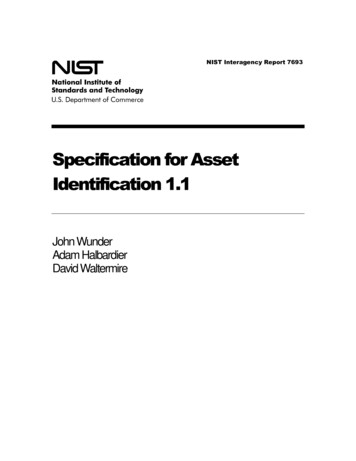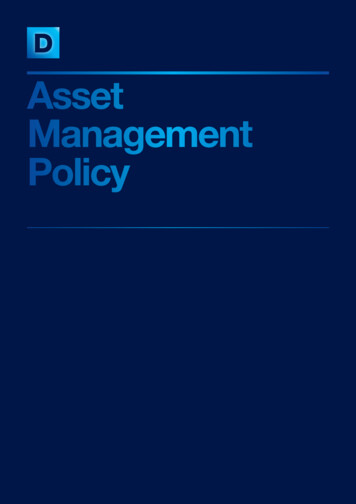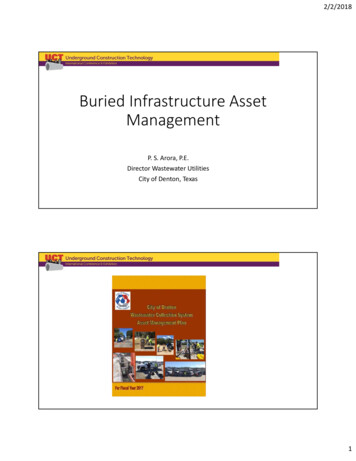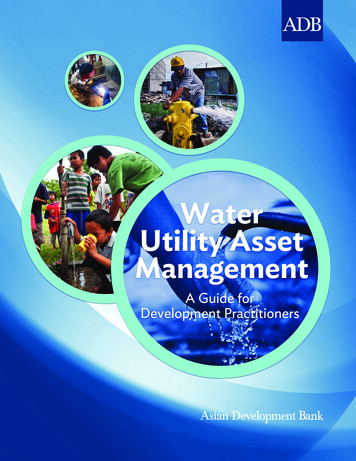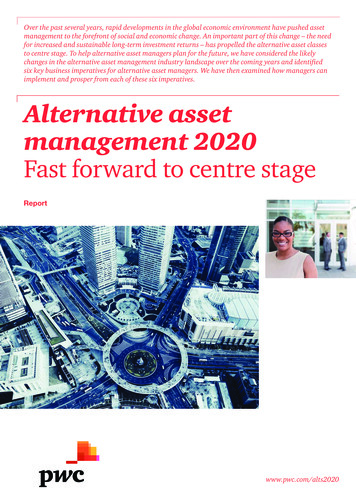
Transcription
Over the past several years, rapid developments in the global economic environment have pushed assetmanagement to the forefront of social and economic change. An important part of this change – the needfor increased and sustainable long-term investment returns – has propelled the alternative asset classesto centre stage. To help alternative asset managers plan for the future, we have considered the likelychanges in the alternative asset management industry landscape over the coming years and identifiedsix key business imperatives for alternative asset managers. We have then examined how managers canimplement and prosper from each of these six imperatives.Alternative assetmanagement 2020Fast forward to centre stageReportwww.pwc.com/alts2020
2 PwC Alternative Asset Management 2020
3 PwC Alternative Asset Management 2020ContentsIntroduction4Executive summary6The alternative asset managementlandscape in 202010Here’s how12Conclusion34Contacts35
4 PwC Alternative Asset Management 2020IntroductionOver the past several years, rapid developments in the global economic environment have pushed assetmanagement to the forefront of social and economic change. The need for increased and sustainablelong-term investment returns are an important part of this change and has propelled alternative assetmanagement to centre stage.Alternative firms, with their emphasis on investment outcomes rather than products, andspecialisation rather than commoditisation, will increasingly attract investors seeking customisation,diversification and genuine long-term alpha. At the same time, alternatives will increasingly occupya prominent allocation in the world’s economies, both established and emerging. Fast-forwarding to2020, alternatives will have a centre stage role to play in the investment universe and in the globaleconomy.Between now and 2020, alternative assets are expected to grow to 13.6tn in our base casescenario and to 15.3tn in our high case scenario. High performance of capital markets driven byaccommodative monetary policies and stable GDP growth would push alternatives towards the highcase scenario. However, the possible rise of interest rates in the US and Europe, coupled with a normalcorrection in the capital markets, would support the base case.Figure 1: Alternative assets in USD tn 2.91.40.82.520072.96.9%2.58.9%8.8%6.57.42020(Base case)2020(High case)3.62013n Private Equity n Real Assets n Hedge Funds & FoHFSource: PwC Market Research Centre analysis based on Prequin, HFR and Lipper data.
5 PwC Alternative Asset Management 2020From now until 2020, thealternative asset managementindustry will experience a periodof transformation as firms lookto calibrate their businesses andoperations as they move to centrestage. The principal focus for manyfirms will shift to creating a broaderasset class and product mix andopening new distribution channels.While some firms still strive tobecome more institutionalised, theleading firms will work to buildindustrial-strength operationalplatforms. They will meet thischallenge by revamping theirbusiness and infrastructure to bemore agile and scalable, with a highdegree of efficiency and operatingleverage.Neither regulation nor investorexpectations are, of course, a ‘donedeal’. Both will still have a majorimpact and produce some significantchallenges as well as opportunitiesin the years to 2020. But leadingalternative firms will, in the comingyears, shift focus and invest moretime and resources on businessstrategy, organisational design anddata-informed decision-making.Unfocused approaches to all will beincreasingly rare.The diversity of the alternativesindustry may mean that measuringbusiness unit and productprofitability is not practical for allfirms, but firms will need to beincreasingly systematic and granularin their analysis of opportunityversus cost. This shift will not comeeasily to all firms in the sector, someof which pride themselves as beingartisanal.But the majority, by 2020, will seethe virtues of becoming fitter forgrowth, agility and profitability.
6 PwC Alternative Asset Management 2020ExecutivesummaryChoose your channelsAlternative firms by 2020 will adopt world-class ideas and practices fromthe broader financial services industry and from traditional asset managers.They will develop more sophisticated market strategies, more focuseddistribution channels and better recognised brands. Most alternative firmswill work out exactly which investor channel or channels they want totarget and develop relevant strategies and products. Some will focus moresystematically on sovereign investors, pension funds, other sophisticatedinstitutions and private wealth markets. Others will target emergingmarkets, and still others will pursue the potentially huge asset flows throughliquid alternative products. A small number of mega-managers in thealternatives space will operate across all major geographies, channels andstrategies.Build, buy or borrowGreater segmentation of investors will, in turn, drive greater segmentationof the managers themselves. Deciding which segment of the market toinhabit will require alternative firms to more consciously evaluate what theyare as an organisation and where they want to be. They will typically aspireto be one of the following types: diversified alternative firms, specialty firmsor multi-strategy firms. All these models exist today; the difference is thatfirms will by 2020 explicitly choose a growth strategy in order to remaincompetitive. To develop the chosen business model, firms will pursueone or more of three growth strategies: building, buying or borrowing.Builders grow by building out their internal organisations, leveraging anddeveloping their existing capabilities and investment talent. Buyers expandtheir alternative capabilities across asset classes and strategies by acquiringtalent, track record and scale overnight. Borrowers partner with otherinstitutions, including asset managers, wealth managers, private banks andfunds-of-funds, to expand their investment capabilities and take advantageof broadened distribution channels. These ‘borrowing’ relationships include,but are not limited to, distribution arrangements, joint ventures and subadvisory relationships.
7 PwC Alternative Asset Management 2020Morestandardisation,more customisationThe polarisation of the alternativesindustry into standardised andcustomised solutions, alreadyin evidence in 2015, becomeseven more marked by 2020.This shift responds to three keyinvestor demands. The first is theongoing demand by the largestinstitutional investors for madeto-order products, providinggreater customisation and strategicalignment. The second is demandfor next-generation commingledfunds that are more focused onoutcomes. The third is demandfor liquid alternative funds instandardised formats as someinstitutional investors, as well as themass affluent and newly wealthy,seek easy access to alternativestrategies.From institutionalquality to industrialstrengthOwners, investors and regulatorswill broaden their expectations from‘institutional quality’ to ‘industrialstrength’. They will expectalternative firms to operate in a waythat goes beyond the prerequisitequality standards to operate evenmore effectively and offer a broaderrange of capabilities. Havinginstitutionalised their businesses,alternative firms will seek the higherstandard of ‘industrial strength’.Firms will revamp their operationsin a cost-effective way that is notdisruptive to their day-to-daybusiness. This includes embeddingmore data-informed decisionmaking to estimate the impactof business mix changes andprocess improvement on costs andrevenues. They will then implementthese process improvements,eliminating operating inefficienciesby automating and outsourcingprocesses. Firms will look totransform labour-intensivefunctions like compliance, tax andinvestor servicing into ones thatare more technology-enabled,scalable and integrated within theoverall operating environment.To do this, larger firms will buildin more resource bandwidth withchange agents who will driveprocess improvement while coreteams continue to drive day-today operations. Firms will alsoseek to better control operationalrisk, systematically identifying,prioritising and managingoperational risks to target areas ofpotential vulnerability.The right resourcesin the right placesBy 2020, the shift to data-informeddecision-making will lead toimproved organisational designsthat can better deliver the rightresources to the right places. Designelements that will be adoptedby alternative firms include:centres of excellence to leverageexpertise; dedicated teams to focuson underserved areas; sourcingstrategies to reduce costs for highvolume, repeatable processes; andlocation strategies to bolster a firm’spresence in a particular jurisdictionor to reduce cost.Many alternative firms will alsomake more effective use of rightsourcing strategies. In some cases,they will shift to using outsourceproviders or utility-like platformswhere key skills or geographiccoverage can be provided more costeffectively, externally. In other cases,alternative firms will continue to usein-house support functions to takeadvantage of operating leveragebenefits. Successful right-sourcingefforts are accompanied by moresystematic and efficient internaloversight to bridge the gap betweenexternal service providers andinternal resources.
8 PwC Alternative Asset Management 2020Analytics enablealternative firmsto better measurethe strength oftheir operationalprocesses andenhance keyfunctional areassuch as tax,compliance,reporting andinvestor servicing.the focus of leading alternative firms willhave largely moved on. They will have laidthe necessary ‘plumbing’, and accessingdata across their organisations will be asnatural as turning on a tap.It’s not only aboutthe dataData and data-centricity are keybusiness imperatives in 2015.By 2020, the focus of leadingalternative firms will have largelymoved on. They will have laid thenecessary ‘plumbing’, and accessingdata across their organisations willbe as natural as turning on a tap.To do this, they will adopt datastandard protocols allowing all partsof the organisation to exchangeinformation, creating a self-servicemodel. These protocols will alsospeed information exchange withkey counterparties and serviceproviders.The result will be a data-centric,self-service environment in whichtime is spent on the analysis andreporting of data, rather than on themanipulation of data. The resultinganalytics enable alternative firms tobetter measure the strength of theiroperational processes and enhancekey functional areas such as tax,compliance, reporting and investorservicing. The model will also helpplug the current drain on resourcesin the manual and non-standardisedareas of portfolio monitoring,operational due diligence andinvestor onboarding.
9 PwC Alternative Asset Management 2020
10 PwC Alternative Asset Management 2020The alternativeasset managementlandscape in 2020The asset management landscape is undergoing radicalchange. This change was set out in a paper PwC published inearly 2014 – Asset Management 2020: A Brave New World.1The paper captures the global trends impacting the industryin the coming years and identifies the consequences of thesetrends. The key predictions it makes are outlined below andsupplemented with a brief analysis of the potential impact onthe alternative asset management sector: A sset management moves centre-stage. Changing demographics andmarkets will thrust asset management to centre-stage. First, regulationwill continue to hinder banks: for alternatives this furthers significantopportunities such as catalyst hires from banks and the opportunity tofurther step into the funding gap. Second, as the world ages, retirementand healthcare will become critical issues that asset management cansolve: capital preservation and alpha generation will be key. Third,asset managers will dominate the capital raising required to supportgrowing urbanisation and cross-border trade: growing asset classesin infrastructure and real estate play into alternatives firms’ areas ofexpertise. Fourth, asset managers will be at the centre of efforts bysovereign investors to invest and diversify their huge pools of assets:alternative firms are ideally positioned to partner with them. Huge rise in assets and shift in investor base. Alternative assets areexpected to grow between now and 2020 to reach more than 13.6tnin our base-case scenario and 15.3tn in our high-case scenario. Assetsunder management in the SAAAME (South America, Asia, Africa andthe Middle East) economies are set to grow faster than in the developedworld as these economies mature. This growth will be evidenced by theprojected emergence of 21 new sovereign investors, the vast majority ofwhich will originate from SAAAME. Growth in assets will be driven principally by three key trends: agovernment-incentivised shift to individual retirement plans; the increaseof high-net-worth-individuals from emerging populations; and thegrowth of sovereign investors. This creates the need for more tailored,outcome-based alternative products that provide capital preservation,but provide upside opportunities.Public pension fund turns toalternativesBy 2020, there will be a fundamental shifttowards alternatives by many sovereignand public pension funds. This is thecontinuation of a trend that first gainedtraction in the US and then globally. InApril 2015, for instance, the world’s largestpension fund, the 1.1tn GovernmentPension Investment Fund (GPIF) of Japanannounced a new strategic asset mix in abid to achieve higher returns and addressthe needs of an ageing population.Significantly, GPIF’s new mandate allowsfor a 5% allocation to alternatives,representing a significant opportunity foralternative firms. And it will not end there.Three smaller funds managing about 250bn – the Promotion and Mutual AidCorporation for Private Schools of Japan,the Pension Fund Association for LocalGovernment Officials, and the Federationof National Public Service PersonnelMutual Aid Associations – plan to adopt amix similar to GPIF.By 2020, it is expected that global pensionfund assets will have reached 56.6tn,with alternative assets expected to playa considerably larger role in their assetallocation mix.Source: Adoption of New Policy Mix (GPIF)October 31, 2014 gpif.go.jpou1 www.pwc.com/AM2020
11 PwC Alternative Asset Management 2020Figure 2: Number of sovereign investors by region1461601401251202111310040200Latin America24Europe252460Sub-Saharan Africa162080North Africa2182425313620152020Middle EastNorth AmericaAsia-PacificSource: PwC Market Research Centre analysis based on sovereign investors’ financial information, SovereignWealth Center, Prequin IFSWF, The Natural Resource Governace Institute and the Columbia Center onSustainable Investment data.Figure 3: Pension fund assets in USD urces: PwC Market Research Centreanalysis based on City UK and Towers Watson37.120132020 CAGR Pressures on the assetmanagement industry.Alongside rising assets, therewill continue to be increasedregulatory requirements, risingcosts and pressure to reduce fees.Alternative firms do not escapethis pressure and will seek torespond proactively. Distribution is redrawn –regional and global platformsdominate. New markets anduntapped investor types willopen up if alternative firms candevelop the products and accessthe distribution channels to tapthem. By the early 2020s, fourdistinct regional fund distributionblocks will have been formedallowing products to be sold panregionally. These are: north Asia,south Asia, Latin America andEurope. However, these blocksbenefit traditional firms more thanalternatives firms, so distributionalliances will be critical foralternatives firms.Alternatives become mainstream. The term‘alternative’, already strained toreflect a mix of different strategies,products and firms, becomesfurther flexed. The growth ofliquid alternative products, eitherin the form of mutual fundsor UCITS, continues to creategreater integration betweenalternative and traditional assetmanagement. By 2020, alternativeasset management will becomesynonymous with ‘active assetmanagement’ and, increasingly,‘multi-asset class solutions’.New breed of global managers. Traditional managers leveragetheir existing platforms,distribution capabilities andbrands to develop full-service,multi-asset class alternativebusinesses. A few of today’s largestdiversified alternative firms willbecome mega-managers in theirown right, establishing a presencein all the key geographies andinvestor segments. The largestalternative firms will continuetheir growth trajectory anddiversification through product,asset class and distributionexpansion, fuelled by build, buyand borrow strategies. Specialistfirms will seek ‘best-of-breed’status by producing sustainedperformance, while certainemerging firms will fight for shelfspace. Asset management enters thetwenty-first century. By 2020,technology and data-informeddecision-making will becomemission critical to drive investorengagement, data analytics,operational and cost efficiency,and regulatory and tax reporting.Data management and investmentin technology have not alwaysbeen a top priority for alternativefirms – this will change.
12 PwC Alternative Asset Management 2020Here’s howSo what do these huge future shifts in the industry mean foralternative firms and how they operate in the years to 2020and beyond?The key business imperatives for alternative firms in2020 will be: Choose your channels Build, buy or borrow More standardisation, more customisation From institutional quality to industrial strength The right resources in the right places It’s not only about the dataThe rest of this section looks at each of these key imperatives in turnand examines how managers of alternative strategies can implementand prosper from them.
13 PwC Alternative Asset Management 2020Choose yourchannelsWorld-class asset managementorganisations may serve manydifferent markets, but they have onething in common: they understandthe different market segments andtailor their products to each market’sunique specifications.Alternative firms will spend a biggerportion of their time and resourcesover the coming years figuring outhow to access the discrete poolsof wealth that will exist by 2020and how to tailor their products toeach pool’s unique specifications.While marketing and distributionchallenges are not unique to thealternatives sector, the solutionsprobably are. This is becausethe distribution landscape foralternatives has been historicallydifficult to navigate. In 2015, fewalternative firms possess brandsthat are well-recognised, wellunderstood and global. In the leadup to the 2020s, leading alternativefirms will have determined exactlywhich investor channels they wantto target and will have developedstrategies for each channel.Here’s how:By the early 2020s, few alternativefirms will still take a scattergunapproach to distribution. Manyfirms will devote more resources todeciding which investor channelsthey want to play in, how profitableeach of those channels are andhow to optimise their chosenchannels. These decisions willrespond to the natural strengthsand goals of firms, but also totheir views on the likely futurebehaviour and needs of investors.Decisions will also respond toviews on regulatory challengesand opportunities that differentchannels and markets present.Regulation brings cost burdens,but it also offers distributionopportunities, particularly for firmswith global operations, firms alreadyaccustomed to registered productsand firms willing to step up to theincreased requirements.The shift in global economicpower from developed regions todeveloping regions drives continuedfocus on sovereign investors,fast-growing institutions and theemerging middle classes in newmarkets. These groups of investorswill increasingly seek brandedmulti-capability firms. A numberof alternative firms exist in thiscategory in 2015, while others willaspire to join them in the 2020sthrough various growth strategies.The sovereign investorchannelBy 2020, sovereign investor assetsare projected to grow by 6.2% to hit 15.3tn.Geographically and economicallydiverse sovereign investors willrequire a highly bespoke approachdue, in large part, to their differenteconomic objectives. Sovereigninvestors, comprising sovereignwealth funds, public pension reservefunds (PPRF)2 and other largepension funds, will continue to seekhigh levels of transparency. Theywill also seek high standards ofgovernance, reporting and economicalignment with alternative firms.Sovereign investors will alsoseek more in-house control andtransparency over their assets. Theyare transitioning from a model ofhiring external asset managersto talent insourcing, and arehiring experts across asset classes,industries and geographies. Wherethey interact with alternative firms,sovereign investors are consolidatingrelationships and seeking innovativeways to align both parties’ economicinterests.2 Source: “Sovereign Wealth and Pension FundIssues” by Adrian Blundell-Wignall, Yu-WeiHu and Juan Yermo,2008
14 PwC Alternative Asset Management 2020Here’s how:Sovereign investorsrequire a directand individualisticapproach to earntheir business.Figure 4: Sovereign investors’ assets in USD .16.36.720122013201420158.9020072020By 2020, there will be moresovereign investor participationin alternatives with the largestincreases in allocations likely tobe private equity, real estate andinfrastructure. Sovereign investorspay a great deal of attention to pastperformance, regardless of the sizeof the asset management firm, sodistribution to sovereign investors isnot limited to mega-alternative assetfirms. If long-term performance isoutstanding, firms of any size cansecure mandates.Sovereign investors require a directand individualistic approach toearn their business. Alternativeasset firms need to thoroughlyunderstand these non-homogeneousinstitutions, their individual needsand objectives, and develop longterm relationships with them.n SWF n PPRFSource: SWF Institute & PwC Market Research CentreAlternatives and sovereign investors: a perfect fit?Sovereign investors usually have one of three economic objectives: capital maximisation, stabilisation and economicdevelopment.Sovereign investors with capital maximisation objectives Search for higher alpha and diversification Alternatives to reach 14% of portfolios in 2020 Private equity allocations by 2020 are expected to increase to 38% of alternative portfolios (36% in 2015) Real estate is expected to increase to 41% of alternative portfolios (from 38% in 2015) Hedge fund allocations and derivatives are projected to decline respectively to 6% (from 10% in 2015) and 2%(from 3% in 2015) Ageing populations and slower economic growth will encourage PPRFs to seek more yield and more alternatives exposure PPRFs will have a more limited risk appetite than sovereign wealth funds due to their explicit pension liabilitiesSovereign investors with economic development objectives Naturally favour infrastructure and private equity investments Alternatives are expected to account for 29% of sovereign investors’ portfolios in 2020 with 79% of that allocation being inprivate equity and infrastructureSovereign investors with stabilisation objectives Shorter investment time horizons Typical asset allocation is highly liquid assets like money market instruments and government bonds Risk appetite is low, so less likely to shift to alternativesSource: PwC SWF2020 and The taxonomy of Sovereign Investment Funds - Richard Boxshall: PwC Market Research Centre analysis based on available recentfinancial information
15 PwC Alternative Asset Management 2020Sovereign investors increasinglyseek to consolidate their managerrelationships and seek bespokesolutions based on their economicobjectives. Instead of simplyallocating large pools of capital tomany alternative firms to manageon a discretionary basis, theyincreasingly prefer to enter intofewer (and broader) strategicrelationships. On the one hand,these strategic relationships involvesovereign investors taking stakes inthe alternative firms themselves.On the other hand, alternativefirms have become more adept atcreating innovative co-investmentand financing arrangements, jointventures, partnerships, advisoryrelationships and dedicated fundsthat allow sovereign investors tomeet their objectives by investingin less traditional and difficult-tomanage assets.As a result, the number of coinvestment deals between sovereigninvestors and alternative firms hasrisen steadily over the last decade,from an annual average of 21co-investment deals between2006-2009, to an annual averageof 40 deals between 2010 and2014.3 The co-investment trend willcontinue over the coming years,with co-investments expected toreach 63 during 2020.3 Source: Sovereign Wealth CentreFigure 5: Completed co-investments deals by sovereign investors alongside firmsby 0062007200820092010Source: PwC Market Research Centre analysisbased on Sovereign Wealth Center data201120122020Including all deals across Asia-PacificEurope, Middle East and North Africa, NorthAmerica, Oceana and sub-Saharan Africa
16 PwC Alternative Asset Management 2020Asia-Pacific’s shareof high-net-worthassets will increaseto 29% by 20204and mass affluentassets will increaseto 43%Emerging markets channelsHere’s how:Latin American and Asian investors,and particularly institutional andhigh-net-worth investors fromChina, represent a significant, andin some cases largely untappedopportunity for alternativefirms. Other Asian markets willpresent opportunities, but nonewill continue to dominate thefocus like China, given its greaterconcentration of high-net-worthindividuals (HNWIs).With private wealth growth inemerging markets outpacingdeveloped markets, wealthmanagement becomes an area ofexplicit focus and differentiation forsome alternative firms. They createbespoke products to match specificcustomer needs in specific emergingmarkets. First mover advantage iscritical.In 2012, almost 24% of the highnet-worth assets and 34% of massaffluent assets around the globeare in Asia-Pacific. It is expectedthat Asia-Pacific’s share of high-networth assets will increase to 29%by 20204 and mass affluent assetswill increase to 43%, much of thatincrease originating from China.As Latin American (LatAm)countries look for alternativeinvestments to domestic bonds,alternative firms have anopportunity to create differentproducts that can attract HNWIsand sovereign investors. There isan appetite by investors to investin projects in LatAm which willcontribute to the development of theregion and produce above-marketreturns.The internationalisation of theChinese currency and Beijing’scontinuous reduction of investmentbarriers will provide opportunitiesfor alternative asset managementfirms by 2020. Among changeslikely to have significance for boththe China and Hong Kong marketsby 2020, several are already inevidence: The launch by a foreign entityof the first Qualified DomesticLimited Partnership (QDLP)hedge fund. The establishment of ShanghaiHong Kong Stock Connect. The launch of duty-free zonesby two Chinese provinces toencourage the establishment offinancial services firms across therespective provinces. The Mainland-Hong Kong MutualRecognition of Funds (MRF)initiative.The Chinese regulatory authoritieswill become more knowledgeableabout different fund structuresleading to a fine-tuning of theirtechnical expertise. A positivefeedback loop will slowly form,giving impetus to the alternativesindustry in mainland China.4 PwC analysis, with past data based on Credit Suisse’s GlobalWealth Report
17 PwC Alternative Asset Management 2020Some international firms on theother hand will focus on developingrelationships with mainland Chineseinvestment banks, partnering withthem to gain access to ChineseHNWIs. Regardless of whichstrategy they pursue, internationalasset managers will face competitionfrom domestic firms. With theirknowledge and access to localmarkets, they will start to competewith international firms. DomesticChinese asset managers, liketheir international counterparts,will also focus on creating globalbrands and on selling their fundsto international investors in Europeand the US.In LatAm, distribution channels areconcentrated among a few firmsand are likely to be controlled bythe biggest banks well beyond2020. In Brazil, for example, theasset management industry isconcentrated among a few big firmswith the top ten asset managersresponsible for 88% of assets undermanagement in the country.5To enhance the distribution ofalternative products within theregion, alternative firms willconsider alliances with local assetmanagers and distributors.By 2020, firms that have successfullyintegrated emerging marketregulatory requirements into aglobal compliance framework willhave a competitive advantage.These firms will have achievedmore consistent, efficient globalcompliance controls, resulting incost savings and reduced regulatoryrisk exposure.Figure 6: High net worth individuals assets in USD tn 9.7%9.0%21.63.4%21.74.4%30.6020122020n North America n Europe n Asia-Pacific n Latin America n AfricaSource: PwC Market Research Centre analysis based on Credit Suisse dataFigure 7: Mass affluent assets in USD tn CAGR1201006.8%1.3%100.44.59.9%0.98
5 PwC Alternative Asset Management 2020 From now until 2020, the alternative asset management industry will experience a period of transformation as firms look to calibrate their businesses and operations as they move to centre stage. The principal focus for many firms will shift to creating a broader asset class and product mix and

